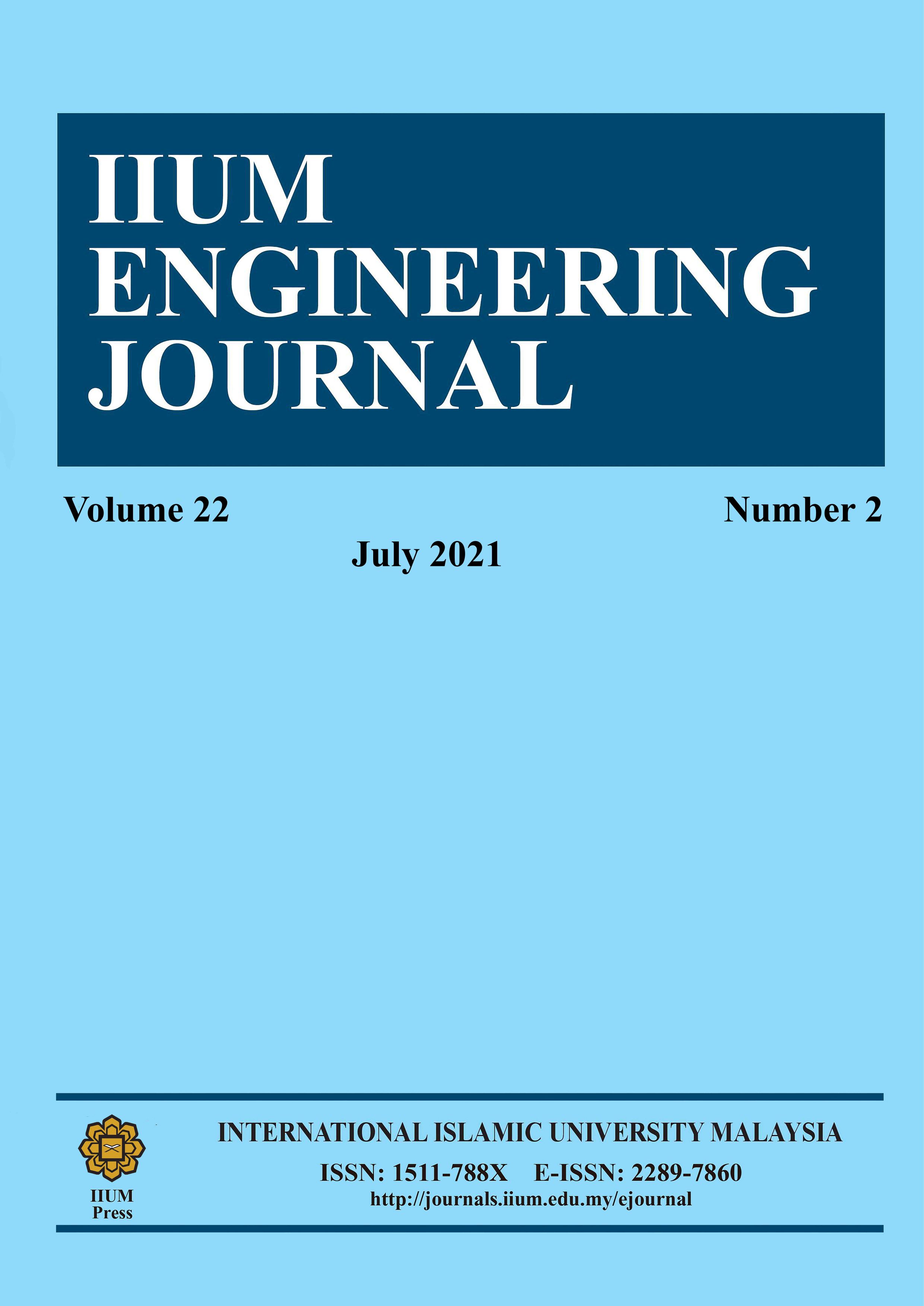MULTI-OBJECTIVE OPTIMIZATION OF SNAKE ROBOT IN SERPENTINE LOCOMOTION
DOI:
https://doi.org/10.31436/iiumej.v22i2.1691Keywords:
Snake Robot, Optimization, Genetic Algorithm, Serpentine LocomotionAbstract
This paper presents multi-objective optimization for a snake robot with serpentine locomotion. Genetic algorithm (GA) is used to achieve two objectives: minimizing the total travelling time and minimizing the total energy consumption. The effect of initial values of winding angle and acceleration on energy consumption and average speed is depicted. The simulation results show a periodic pattern of the joint torques when the robot maintains a serpenoid curve during travel. Moreover, a Pareto-optimal front was generated for optimal solutions of both of the objectives, while the weighted sum method was used for selecting the best solution. Finally, the simulation results were verified experimentally on an eight-link snake robot considering the limitations of the servomotors used in the experiment. The experimental results with the winding angle of 30° was found as the optimum winding angle that can achieve both objectives of minimizing the energy consumption and the travelling time.
ABSTRAK: Kajian ini berkenaan pelbagai-objektif optimum bagi robot ular dengan gerakan serpentin. Algoritma genetik (GA) diguna bagi mencapai dua objektif ini iaitu mengurangkan jumlah masa gerakan dan guna tenaga. Gambaran kesan awal nilai sudut belitan dan pecutan pada guna tenaga dan purata kelajuan dihasilkan. Dapatan simulasi menunjukkan corak berkala tork sendi yang tetap terhasil semasa robot ini berkeadaan lengkung serpenoid ketika bergerak. Tambahan, Pareto-optimal berdepan terhasil bagi solusi optimum pada kedua-dua objektif, sementara kaedah berat campuran digunakan bagi menentukan solusi terbaik. Akhirnya, dapatan simulasi disahkan secara eksperimen pada robot ular lapan-bahagian dengan menimbangkan kekurangan servomotor yang digunakan dalam eksperimen. Dapatan eksperimen menunjukkan sudut belitan 30° adalah sudut belitan optimum bagi kedua-dua objektif iaitu mengurangkan tenaga dan masa gerakan.
Downloads
Metrics
References
Gray J. (1946) The mechanism of locomotion in snakes. Journal of Experimental Biology, 23(2): 101-120. DOI: https://doi.org/10.1242/jeb.23.2.101
Hirose S, Mori M. (2004) Biologically inspired snake-like robots. Robotics and Biomimetics, 2004. ROBIO 2004. IEEE International Conference on (pp. 1-7). IEEE.
Hirose S. (1993) Biologically inspired robots: snake-like locomotors and manipulators, vol. 1093. Oxford: Oxford university press.
Saito M, Fukaya M, Iwasaki T. (2002) Modeling, analysis, and synthesis of serpentine locomotion with a multilink robotic snake. IEEE Control Systems Magazine, 22(1): 64-81.
Chen L, Ma S, Wang Y, Li B, Duan D. (2007) Design and modelling of a snake robot in traveling wave locomotion. Mechanism and Machine Theory, 42(12): 1632-1642.
Chernousko FL. (2005) Modelling of snake-like locomotion. Applied mathematics and computation, 164(2): 415-434. DOI: https://doi.org/10.1016/j.amc.2004.06.057
Ariizumi R, Matsuno F. (2017) Dynamic analysis of three snake robot gaits. IEEE Transactions on Robotics, 33(5): 1075-1087. DOI: https://doi.org/10.1109/TRO.2017.2704581
Sanfilippo F, Azpiazu J, Marafioti G, Transeth AA, Stavdahl Ø, Liljebäck P. (2017) Perception-driven obstacle-aided locomotion for snake robots: the state of the art, challenges and possibilities. Applied Sciences, 7(4): 336. DOI: https://doi.org/10.3390/app7040336
Wang Z, Gao Q, Zhao H. (2017) CPG-inspired locomotion control for a snake robot basing on nonlinear oscillators. Journal of Intelligent & Robotic Systems, 85(2): 209-227. DOI: https://doi.org/10.1007/s10846-016-0373-9
Trebu?a F, Virgala I, Pástor M, Lipták T, Miková ?. (2016) An inspection of pipe by snake robot. International Journal of Advanced Robotic Systems, September-October, 1-12. DOI: https://doi.org/10.1177/1729881416663668
Bando Y, Suhara H, Tanaka M, Kamegawa T, Itoyama K, Yoshii K, ... & Okuno HG. (2016) Sound-based online localization for an in-pipe snake robot. in 2016 IEEE International Symposium on Safety, Security, and Rescue Robotics (SSRR) (pp. 207-213). IEEE. DOI: https://doi.org/10.1109/SSRR.2016.7784300
Whitman J, Zevallos N, Travers M, Choset H. (2018) Snake robot urban search after the 2017 Mexico City earthquake. 2018 IEEE international symposium on safety, security, and rescue robotics (SSRR) (pp. 1-6). IEEE. DOI: https://doi.org/10.1109/SSRR.2018.8468633
Chen L, Ma S, Wang Y, Li B, Duan D. (2007) Design and modelling of a snake robot in traveling wave locomotion. Mechanism and Machine Theory, 42(12): 1632-1642. DOI: https://doi.org/10.1016/j.mechmachtheory.2006.12.003
Saito M, Fukaya M, Iwasaki T. (2002) Modeling, analysis, and synthesis of serpentine locomotion with a multilink robotic snake. IEEE Control Systems Magazine, 22(1): 64-81. DOI: https://doi.org/10.1109/37.980248
Kelasidi E, Jesmani M, Pettersen KY, Gravdahl JT. (2018) Locomotion efficiency optimization of biologically inspired snake robots. Applied Sciences, 8(1): 80. DOI: https://doi.org/10.3390/app8010080
Liu J, Wang Y, Ii B, Ma S. (2004) Path planning of a snake-like robot based on serpenoid curve and genetic algorithms. in Intelligent Control and Automation, 2004. WCICA 2004. Fifth World Congress on (6: 4860-4864). IEEE.
Hasanzadeh S, Tootoonchi AA. (2008) Adaptive optimal locomotion of snake robot based on CPG-network using fuzzy logic tuner. in Robotics, Automation and Mechatronics, 2008 IEEE Conference on (pp. 187-192). IEEE. DOI: https://doi.org/10.1109/RAMECH.2008.4681403
Jafari M, Shahmansoorian A. (2014). PI/backstepping control of snake robot optimized by genetic algorithm. In Electrical and Computer Engineering (CCECE), 2014 IEEE 27th Canadian Conference on (pp. 1-6). IEEE. DOI: https://doi.org/10.1109/CCECE.2014.6901044
Rao SS, Rao SS. (2009) Engineering optimization: theory and practice. John Wiley & Sons. DOI: https://doi.org/10.1002/9780470549124
Marler RT, Arora JS. (2010). The weighted sum method for multi-objective optimization: new insights. Structural and multidisciplinary optimization, 41(6): 853-862. DOI: https://doi.org/10.1007/s00158-009-0460-7
Downloads
Published
How to Cite
Issue
Section
License
Copyright (c) 2021 IIUM Press

This work is licensed under a Creative Commons Attribution-NonCommercial 4.0 International License.






















